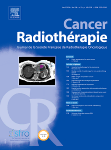
Publication date: Available online 7 September 2016
Source:Cancer/Radiothérapie
Author(s): J. Doyen, P.-Y. Bondiau, K. Benezery, J. Thariat, M. Vidal, A. Gérard, J. Hérault, C. Carrie, J.-M. Hannoun-Lévi
L'objectif de l'étude était de faire le point sur les résultats dans les principales indications de protonthérapie dans les cancers. Une revue systématique de la littérature a été réalisée par une sélection des études sur le site internet www.pubmed.com (Medline) à l'aide des mots-clés suivants : proton therapy, radiation therapy, cancer, chordoma, chondrosarcoma, uveal melanoma, retinoblastoma, meningioma, glioma, neurinoma, pituitary adenoma, medulloblastoma, ependymoma, craniopharyngioma et nasal cavity. Il existe de nombreuses études rétrospectives pour les indications classiques de protonthérapie qui sont les suivantes : tumeurs oculaires, des sinus, de la base du crâne et pédiatriques. Il n'existe toutefois aucune étude prospective, à part une de phase II dans le médulloblastome. L'utilisation de la protonthérapie dans ces indications est le fait d'un avantage dosimétrique qui prédit à doses égales avec la photonthérapie, une meilleure couverture tumorale et/ou un profil de toxicité plus favorable. En termes de contrôle tumoral, les protons sont historiquement au moins aussi efficaces que la photonthérapie, avec un profil de toxicité plus favorable prouvé pour les enfants (fonctions cognitives, fonction endocrinienne, cancers radioinduits) et un meilleur taux de contrôle tumoral pour les tumeurs des sinus du massif facial. Les avantages cliniques contrebalancent le coût de la technique dans les tumeurs pédiatriques en particulier. La protonthérapie pourrait, selon la situation, être proposée dans d'autres types de cancer. La protonthérapie a montré de bons résultats dans la prise en charge des tumeurs oculaires, des sinus de la face, des tumeurs pédiatriques, des tumeurs de la base du crâne et parachidiennes. Du fait des avantages dosimétriques de la technique, d'autres indications pourraient être posées à l'avenir.Purpose was to summarize results for proton therapy in cancer treatment. A systematic review has been done by selecting studies on the website www.pubmed.com (Medline) and using the following keywords: proton therapy, radiation therapy, cancer, chordoma, chondrosarcoma, uveal melanoma, retinoblastoma, meningioma, glioma, neurinoma, pituitary adenoma, medulloblastoma, ependymoma, craniopharyngioma and nasal cavity. There are several retrospective studies reporting results for proton therapy in cancer treatments in the following indications: ocular tumors, nasal tumors, skull-based tumors, pediatric tumors. There is no prospective study except one phase II trial in medulloblastoma. The use of proton therapy for these indications is due to dosimetric advantages offering better tumor coverage and organ at risk sparing in comparison with photon therapy. Clinical results are historically at least as efficient as photon therapy with a better toxicity profile in pediatric tumors (cognitive and endocrine functions, radiation-induced cancer) and a better tumoral control in tumors of the nasal cavity. Clinical advantages of proton therapy counterbalance its cost especially in pediatric tumors. Proton therapy could be used in other types of cancer. Proton therapy showed good outcome in ocular, nasal tumors, pediatric, skull-based and paraspinal tumors. Because of some dosimetric advantages, proton therapy could be proposed for other indications in cancer treatments.
from Cancer via ola Kala on Inoreader http://ift.tt/2cc5Bjw
via
IFTTT
